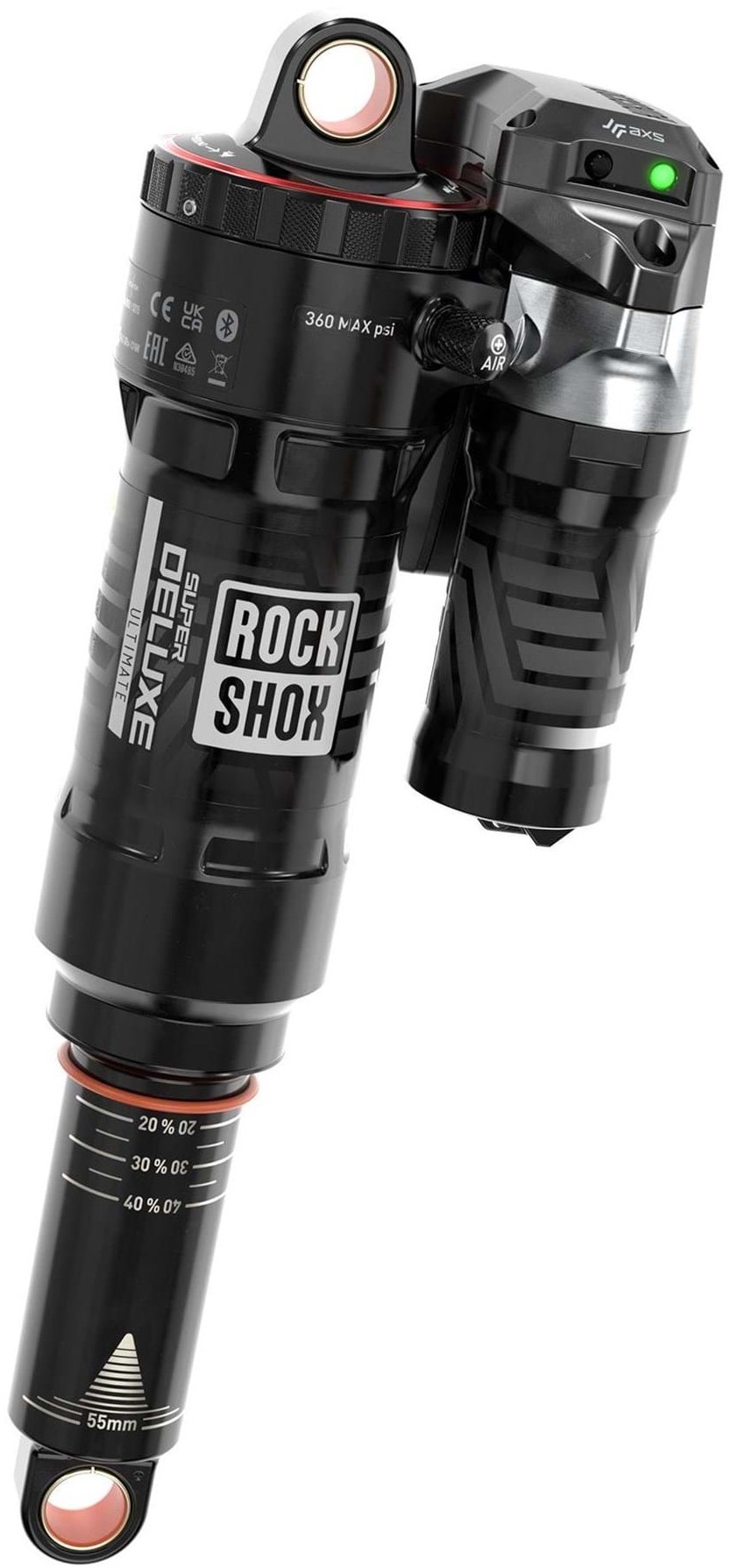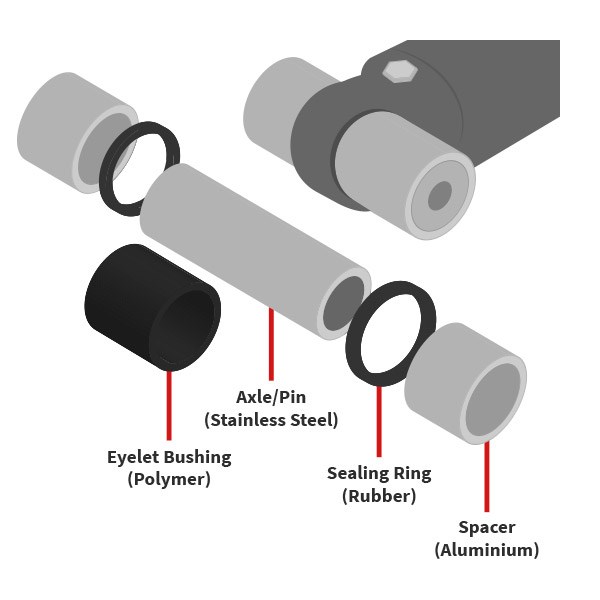RockShox Super Deluxe Ultimate Flight Attendant Linear Air Rear Shock





- NEW Remove suspension complexity to elevate your ride experience. Flight Attendant has an all new algorithm that uses a suite of sensors to read rider and terrain inputs to anticipate the perfect suspension position. No other suspension system has this level of personalization to match your riding preferences, your terrain, your style, and your physical capabilities. Elevate your ride.
- NEW Flight Attendant RC3 electronic damper features a 3-position compression adjust (Open/Pedal/Lock position) and independent adjustable Low Speed Compression.
- NEW High-flow main piston reduces high speed compression damping, eliminating hang-ups and allows the wheel to easily get out of the way on hard impacts.
- DebonAir+ Linear and Progressive air springs maximizes fine-tuning potential, allowing you to tune both the negative and positive air volume to perfectly match your bike, desired ride feel, and the trail ahead.
- The optional Hydraulic Bottom Out kicks in to restrict the flow of oil within the last 20% of travel, offering a soft hydraulic cushion that reduces harsh bottom out.
- 15 clicks of Rebound adjustment offer a wider range of tunability and accommodate more rider types.
- Castled bottom out bumper reduces harsh bottom-out, leaving extra room for the bold to go big.
- Independently tuned Open, Pedal, and Lock modes to find the perfect tune for every bike.
- Maxima Plush Dynamic Suspension Lube reduces friction, lasts longer, and enhances suspension performance, ride after ride.
- Can only be used with the complete 3-part Flight Attendant system (fork, rear shock, power meter).
Occasionally, without notice, manufacturers change product design and/or specifications.
Rear Shocks Sizing
It is not as simple as just bolting on any rear shock, there are some very important measurements to take into consideration.
Once the spring type (air or coil) has been decided, there two fundamental measurements needed.

Eye to eye: The total shock length. Measurement is made between the centres of each mounting hole/bolt in a straight line. This must match the new shock and is listed by the frame manufacturer in either mm or inches, often along with the stroke length. eye to eye is listed first and stroke length second. For example, 190mm x 50mm or 7.5” x 2.0“
Stroke length: The amount of travel the shock has (not the bike) can be seen by how much the telescopic part of the shock moves under full compression. Either the shaft itself can be measured or it can be worked out from the difference between the eye-to-eye length when fully extended, and fully compressed. Shown as the second number in the shock size by the manufacturer (eg 190mm x 50mm or 7.5” x 2.0”), this again should be the same as the original shock and as intended by the frame manufacturer to work with that particular linkage design.
Mounting hardware
Hardware includes the bushings and bolts that fit into the eyelets at either end of the shock, allowing it to be fitted to the frame. Although standards are starting to settle, the hardware will vary with each frame and shock combination. If replacements are needed there are dedicated suspension tuning specialists who can supply these parts.

Coil Shocks
Coil shocks can be tuned to your riding style by using a spring with the correct spring rate for your weight. The best spring for you will most likely be purchased separately, some riders will find they experiment with different springs to find their best set up.
Springs are rated by pounds (lbs) and this should be printed on the spring along with the travel length of the spring in inches. For example 400 lbs x 2.25”.
Coil springs are available in either steel or titanium, there is no noticeable performance difference between the two apart from the weight advantage of titanium.
Most people will experiment with spring rates to find the right spring for them, although a few turns of preload can be added when setting sag it is always best to find the correct spring rate for your weight, riding style, and frame.
Jargon Buster
Attack position – body position of the rider when riding into a technical section of trail, braced for any trail feature with weight balanced in the centre of the bike.
Compression – Controlling how the suspension moves through the available travel.
High-speed compression – How the suspension moves through the travel from High-speed hits not high-speed riding, for example rocks, roots, braking bumps, landing from jumps/drops etc.
Low-speed compression - How the suspension moves through the travel from low speed movement not low-speed riding, for example when under compression through a berm, going up a transition of a jump etc.
Linear – The strength required to compress the spring remains the same through the full movement.
Progressive – The strength required to compress the spring increases progressively through the full movement.
Metric – Referring to the eye-to-eye measurement of a shock in mm rather than inches.
Piggy-back – An extra part of the shock that comes out from the main body. This gives a larger oil volume for internal damping, offering better damping control and more consistent performance on extreme terrain. The frame design must have the space for this larger type of shock and will not fit all bikes.
Preload – How much the coil spring is compressed in its static state.
Rebound – how fast a shock returns to full extension.
Sag – how much travel is used under rider weight.
Shock pump – A high pressure air pump used to adjust air shocks, running at a much higher pressure than a normal inner tube/tyre pump.
Spring rate – The force needed to compress the shock.
Stroke length – the amount of travel the shock has, not the same as the amount of travel the bike has.
Trunnion – A trunnion mount shock has a larger body where one eyelet is housed in the body. This allows a longer stroke length in a shorter eye-to-eye.
Volume spacers – Internal plastic spacer that can be added inside an air shock to reduce internal air volume and so increasing the progression of the shock through its travel.
Customer reviews and Q&A's are disabled because you declined functional cookies.
To enable reviews and Q&A's click the 'Cookie Settings' button below and enable functional cookies.

RockShox Super Deluxe Ultimate Flight Attendant Linear Air Rear Shock
Cycle to Work is a salary sacrifice scheme, where you can save up to 42% off a new Bike and Safety equipment. This means the cost is deducted from your salary as a non-cash benefit, so you save on tax and national insurance.
Here at Tredz, we accept Cycle to Work vouchers from all national schemes. For more information click here.
We understand that the Cycle to Work process can be a little slower than we would all like - so to help you pick the perfect ride, we're now offering FREE Cycle to Work Reservations (T&C's apply). Simply speak to a member of our Online Bike Experts Team via Live Chat to discuss your reservation. Find out more here.
At Tredz we make finance easy. You can choose from a range of flexible finance repayments from 6 months up to 48 months, choose to place a deposit and pay the balance on finance. Go with a 0% APR finance deal with absolutely no interest on payments, or a 9.9% APR Buy Now Pay later option with a choice of 12 or 24 deferred payment options, or a longer-term 14.9% APR option with lower monthly payments. For more information click here.
At Tredz, we’re committed to bringing you the best products at the best prices. If you find a product cheaper elsewhere, simply contact us for an immediate response using our live chat service. Click here to discuss your price match with an agent now for help.
Subject to Terms and Conditions
At Tredz, we offer a fast high quality service, with a range of options from free delivery on orders over £30, next day and convenient click & collect from one of our stores. Simply select within the checkout.
*Courier deliveries to Northern Ireland, Isle of Man, Isle of Wight, Channel Islands and the Scottish Highlands/Islands will incur a charge.At Tredz, if you are not 100% happy with your order, then you can use our simple hassle free returns service. Simply return the item new and unused in the manufacturers original packaging within 365 days of purchase. Bikes and larger items are collected by courier.
When you receive your bike, all you'll need to do is unpack it, attach the pedals, turn the handlebars and ride.
To help you get started we have put together a handy Bike Building Guide, click here.